Designerly Ways of Knowing #47: The Politics of Design
Design is never neutral!
In this new series, I explore designer, educator, and researcher Danah Abdulla’s prompts from her book "Designerly ways of knowing: a working inventory of things a designer should know." which challenge us to expand our knowledge and strengthen our commitment to making the world a better place through design.
#47. The Politics Of Design
“Much, if not most, graphic design is about communicating messages, and many of these messages are intended to persuade. This places its practice clearly in the realm of politics.” - Michael Bierut
Design is political.
Design is a way to shape how humans live, behave, and communicate, for better or for worse, which makes design a political activity.
The political nature of design is evident in key parts of the design process itself. From who we include or exclude to be on our design teams, in our research and testing, and who we market our products to, all point to the political nature of design.
Why is design political?
Carries a bias and an agenda towards achieving a goal
Reflects specific ideological viewpoints
Shapes social norms and influences how we behave and perceive things
Guides how problems and solutions are presented
As Ruben Pater reminds us in The Politics of Design:
At the root of miscommunication lies the assumption that people will understand us because we use ‘universal’ or ‘objective’ communication. Assumptions of objectivity and universality in design are closely tied to the modernist design principles as they are taught in Western design education.”
Our Responsibilities as Designers
Knowing all this, what are the responsibilities for us as designers?
It means we must:
Question and acknowledge our privilege
Ask ourselves, “Who is being excluded from this conversation?” so we can understand the real impact of our designs
We can create space for underrepresented and marginalized voices to be heard
Challenge the status quo by bringing diversity into the names, images, and photos of real people we use in our design process
Design is never neutral. The question is what values, perspectives, and futures will our work stand for?
Reflection Prompt
💬 When you think about a recent project, what choices do you see now that reveal design is never neutral?
Share your thoughts in the comments!
Mindful, by design.
The Mindful Designer is a space to pause, reflect, and explore the ideas that shape how we design and how design shapes us.





